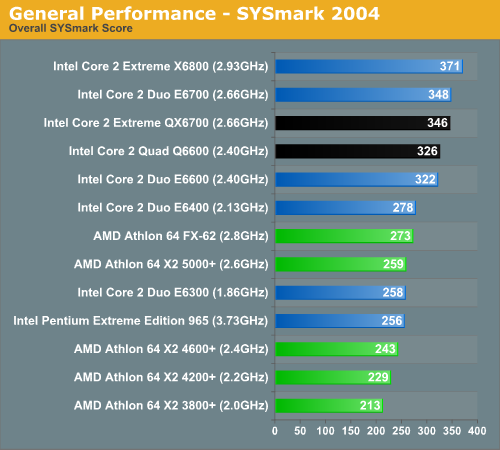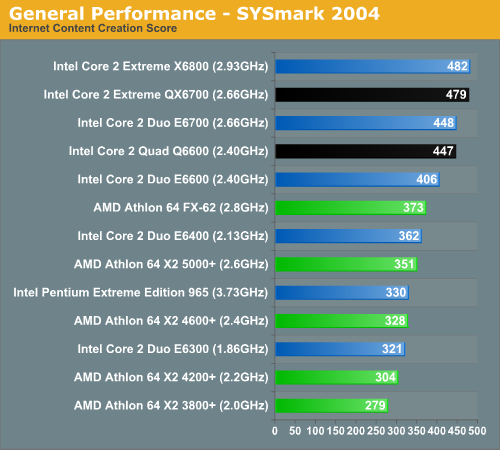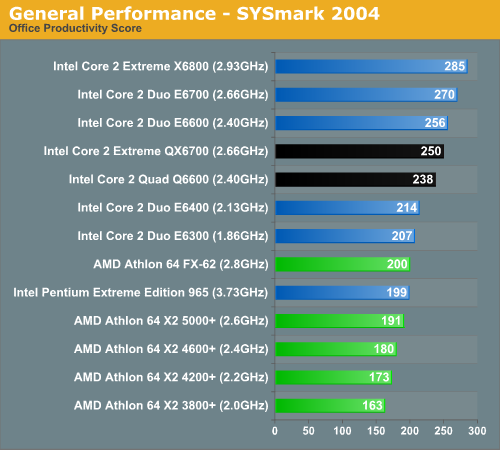Intel's Core 2 Extreme QX6700: The Multi-core Era Begins
by Anand Lal Shimpi on November 2, 2006 2:14 AM EST- Posted in
- CPUs
Application Performance using SYSMark 2004 SE
No article looking at a new processor release would be complete without benchmarks. However, let us preface the benchmark section by stating that the benchmarks don't tell the whole story. There are numerous benchmarks and tasks that you can run that will actually show quad core processors in a better light. A lot of people will never use the applications related to these benchmarks, so in one sense we could say that most people should already know whether or not they need quad core processing. There is also definitely an element of future proofing your system by purchasing quad core now, with the hope that it will be more useful at some point during the life of the system. We definitely do not expect to see large gains in performance in most of the benchmarks we will run, simply because they were not designed or optimized to run on multi-core systems. We will also have some benchmarks that clearly do show vast improvements by moving from dual cores to quad cores, although we've already seen coverage of this in our Kentsfield preview.

We'll start with SYSmark 2004, a benchmark suite that does have some multitasking components and multithreaded applications, but which also includes plenty of work that benefits very little from dual cores let alone quad cores. The overall scores show the quad core processors to basically be equal to their dual core counterparts in terms of performance, with the margin of error accounting for the slight differences in score. Having two more processor cores did almost nothing for SYSmark 2004, and we would expect that to be the case with many business/office applications. Drilling down into the individual results gives us a bit more information, however.


The Internet content creation score clearly does benefit by adding extra processing cores, although not a lot. The Core 2 Quad systems are more or less able to match Core 2 Duo chips clocked one bin higher. The Office Productivity scores show the exact opposite: Core 2 Quad chips are slower than Core 2 Duo chips with the same clock speed. In an ideal world, this shouldn't happen, as all other things being equal having more processor cores should not slow down your overall performance. At some low level, however, there appears to be some resource contention or operating system inefficiencies. The SYSmark 2004 overall score is a good representation of what the end-user will truly experience for this sort of application: the difference between dual cores and quad cores really isn't very apparent if you are a more or less "typical" user.










59 Comments
View All Comments
JarredWalton - Thursday, November 2, 2006 - link
I am quite sure that 4x4 is for 1207 and not AM2. Sorry. I am also quite sure that 1207 will get quad core support, so long-term a 4x4 (dual dual core) can become... 4x8? (dual quad core). Anyway, in that sense it's just like Core 2 Duo and Quad.The questions I don't have answers to: will the 4x4 begin with a K8L chip, or just a tweaked K8? Will K8L be more competitive with Core 2? When will it finally come out? How much will it cost? Actually, I can sort of guess on the last point that 4x4 will cost a lot more than a Core 2 Quad config as you will need a more expensive mobo, RAM, and two CPU packages.
I *think* Anand plans to have an article delving into 4x4 and AMD's plans more in the future. Maybe he's still gathering data from AMD? (Sort of like squeezing water from a dry spongue at times, unfortunately....)
johnsonx - Thursday, November 2, 2006 - link
I don't think you're right on that one; 4x4 CPU's will use the same RAM as AM2 CPU's do. The "more expensive RAM" requirement is only for Opterons, which of course use registered ECC memory. In fact, if your chosen mainboard has memory banks for both CPU's, then you could even save a little since 4 smaller DIMMs tends to cost a little less right now than 2 bigger DIMMs.
JarredWalton - Thursday, November 2, 2006 - link
Except that like socket 940 vs. 939, I expect all 1207 boards to require registered DIMMs. I don't know of any dual socket board that doesn't.Griswold - Thursday, November 2, 2006 - link
The whole "catch" of 4x4 was that there are no ECC/Registered DIMMS required - at least that was the synopsis all the time. It should have very little to do with the socket itself, rather a matter of IMC, no?Anand Lal Shimpi - Thursday, November 2, 2006 - link
You're correct, 4x4 will use Socket-1207 CPUs but without Registered memory.Take care,
Anand
JarredWalton - Thursday, November 2, 2006 - link
I stand corrected, though I have to say I'm still not at all interested in getting a dual socket motherboard. LOL I guess 1207 CPUs will have to support both registered and unbuffered DIMMs? I can't imagine AMD trying to get people to make sure they get the right type of CPU for the RAM they're using.Second thought: could they have mobos and CPUs that will support both registered and unbuffered DIMMs? I think they have the same keying, so it's possible, right?
smilingcrow - Thursday, November 2, 2006 - link
Two dual-core 90nm 120W CPUs = No thank you.Two quad-core 65nm xW CPUs = interesting!
Jedi2155 - Thursday, November 2, 2006 - link
I'm personally a extremely heavy multi-tasker and I can't wait for quad to a hit a more managable price range. At the moment, they're just beyond my reach for a CPU alone. Once it hits around 300-500 then I would definitely buy one, but these right now are still for the rich and video encoders.AlabamaMan - Thursday, November 2, 2006 - link
I am still amazed by the fact that a $300 E6600 consistantly beats the $700 FX62Aikouka - Thursday, November 2, 2006 - link
That fact, my friend, is why I'm purchasing an E6600 in this upcoming week :). Simply the best performance without overclocking for the buck.